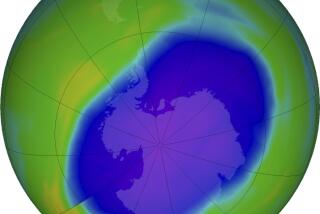Ozone Depletion Prompts Warning in Southern Chile
- Share via
PUNTA ARENAS, Chile — A wide swath of southern Chile was on alert Monday as dangerous levels of ultraviolet radiation hit peaks because of the depletion of the protective ozone layer over the Antarctic.
Health authorities warned the 120,000 residents of this fishing and wool-producing city--one of the few populated areas beneath the ozone hole in the Southern Hemisphere--not to go out in the sun.
The ozone hole over the Antarctic this year is at its deepest level since scientists began measuring it 15 years ago, with more than 50% depletion being recorded throughout most of the hole, United Nations experts said Friday.
That has left this windy city 1,400 miles south of Chile’s capital, Santiago--and also the Argentine city of Ushuaia on the nearby island of Tierra del Fuego--open to harmful ultraviolet radiation, which can cause skin cancer and destroy tiny plants in the food chain.
The tip of the Americas is the only landmass outside the Antarctic exposed to ultraviolet radiation from the ozone hole.
Experts from the U.N. World Meteorological Organization said “near total destruction” of the ozone in some layers of the stratosphere had been observed since mid-September, much earlier than in previous years.
Chemicals--including chlorine compounds used in refrigerants, aerosol sprays and solvents--and bromine compounds used in firefighting halogens are blamed for the depletion.
More to Read
Sign up for Essential California
The most important California stories and recommendations in your inbox every morning.
You may occasionally receive promotional content from the Los Angeles Times.













